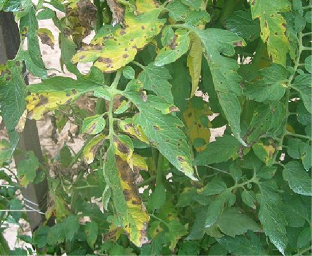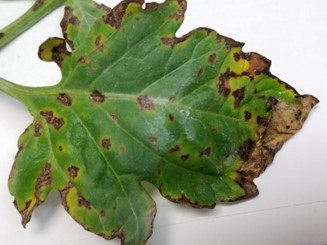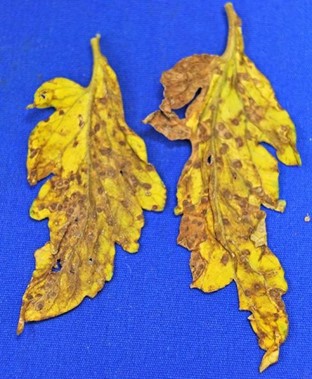Disease Notes
Contact
Plant Diagnostician
Phone: (479) 575-2727
Email: ssmith@uada.edu
Jason Pavel
Diagnostician
Phone: (479) 575-7257
Email: jpavel@uada.edu
University of Arkansas System Division of Agriculture
Cralley Warren Building
Room 16
2601 N. Young Ave.
Fayetteville, AR 72704
Tomato – Septoria Leaf Spot
by Sherrie Smith and Jason Pavel

Tomato Septoria Leaf Spot – Septoria lycopersici
Photo by Keith Gresham, University of Arkansas Cooperative Extension
Septoria Leaf Spot caused by Septoria lycopersici is one of the most damaging diseases of tomato foliage. Warm temperatures and high humidity are favorable conditions for this disease.
What are the symptoms of Septoria Leaf Spot?
Symptoms of Septoria generally appear on the lower leaves after the first fruit sets. Lesions are circular, about 2.6mm in diameter, with dark brown margins with tan to gray centers. Often a narrow yellow halo may be observed around the lesion. Using a hand lens, you can detect small black fruiting bodies of the fungus (pycnidia) in the centers of the lesions. Lesions may coalesce to form large, blighted areas. Badly affected leaves turn yellow, then brown, and fall off the plant.

Tomato Septoria Leaf Spot – Septoria lycopersici
Photo by Sherrie Smith, University of Arkansas Cooperative Extension
How do you control Septoria Leaf Spot in tomato plants?
There are no resistant cultivars available. Control measures include crop rotation with a non-host, control of weeds in tomato crops, removal of all crop debris, and avoidance of night watering and overhead irrigation. Protective fungicides at regular intervals during the growing season will be necessary for most growers. Quadris, Cabrio, Flint, Bravo, Mancozeb, and Gavel are labeled for Septoria leaf spot control.
Homeowners may use Ortho Garden Disease Control, Ferti-lome Liquid Fungicide, Garden Tech Daconil Fungicide Concentrate, Bonide Mancozeb Flowable with Zinc, or Green Light Tomato and Vegetable Spray. Organic Gardeners may try Bayer Advanced Natria Disease Control, Bonide Liquid Copper Fungicide Concentrate, Kaligreen, Bonide Remedy, Bonide Copper Dust, Hi-Yield Bordeaux, or AgraQuest Serenade.

Tomato Septoria Leaf Spot – Septoria lycopersici
Photo by Rick Wimberley, University of Arkansas Cooperative Extension
Take Aways
- Practice crop rotation.
- Avoid overhead irrigation and night watering.
- Apply fungicides early in the season.
This work is supported by the Crop Protection and Pest Management Program [grant no. 2017-70006- 27279/project accession no. 1013890] from the USDA National Institute of Food and Agriculture.